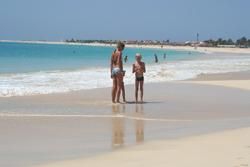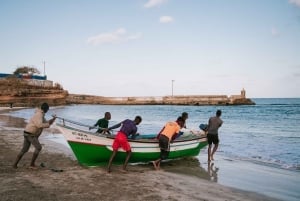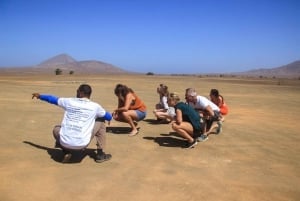Cape Verde Economy
Cape Verde
A rising African economy
With limited natural resources and frequent droughts, Cape Verde relies almost exclusively on the service industry for its national GDP. Thanks to democratic stability, touristic development and an intelligent use of international aid, in 2007 Cape Verde became only the second country in Africa to graduate out of the least developed and into the developing country category.
Domestic Product
As agriculture is only sustainable in four out of Cape Verde´s ten islands, the country imports 90% of the food consumed within its territory. This contributes to a high trade deficit, which is partially remedied by remittances from the diaspora that make up 20% of the GDP. The government has also sought to attract investments from Cape Verdean emigrants, by offering them tax incentives.
In this service-oriented economy, commerce, transport, and public services make up 70% of GDP, agriculture only 9.2% and fishing 1.5%. Though fish and other sea products are abundant in Cape Verde´s territorial waters, this potential is yet not exploited in full.
Since the early 1990´s Cape Verde has focused on the growth of the private sector and foreign investment., with tourism, energy, fisheries and transport among its top priorities.
Strategic position
Cape Verde's strategic geographical position for both air and sea lanes has been crucial for the country´s development. While Sal is a refuelling spot for air traffic, the Porto Grande harbour in Sao Vicente fulfils the same role for ocean routes. In order to capitalize on these assets, there have been major investments on improving harbour and airport facilities through programs sponsored by international organizations such as the World Bank. Today, there are many direct flights from both mainland Europe and the UK to Cape Verde´s main international airports in Sal and Santiago, but also to Boa Vista and Sao Vicente, while the rest of the inhabited Islands offer some local flights.
WTO and IMF
In 2007, Cape Verde was accepted as a member of the World Trade Organization. This membershjp has also been essential for further integration of Cape Verde into the world economy. In November of 2010, the International Monetary Fund (IMF) approved a 15-month Policy Support Instrument (PSI) for Cape Verde; a plan devised to help countries not seeking direct IMF assistance, but rather its advice for a sustainable development and poverty reduction.
Foreign investment
Cape Verde has been attracting billions of dollars in foreign investment every year (3.593 billion DFI -direct foreign investment- for 2008), with the tourism industry leading the way by far (99% of DFI in 2008).
A former Portuguese colony, Cape Verde has traditionally received investment from the Iberian Peninsula. Italy has also been a prominant investor in the development of Cape Verde, constructing Sal International aiport back in 1939 and more recently in the tourism sector. Cape Verde has more recently been successful in attracting other European investors, such as Britain, Netherlands, Sweden and Belgium, and in the later years, China has also become one of the top investors in the Cape Verde economy. Chinese investors are in fact funding everything from renewable energy facilities and dams to government palaces and tourist complexes.
EU partnership
In April 2010, Cape Verde entered a special partnership with the European Union, which has been facilitating both economic cooperation and investment as well as mobility. According to the European Union´s representative in Praia, Josep Coll, Cape Verde´s "graduation to middle-income country, clearly a success story within the African context of a well-managed development policy, and its desire to join and contribute in the global world are more than enough for the EU to be present in the country and want to work with it, toward fulfilling the ambitions of both sides."
This special partnership with the EU has been deemed extremely successful, and it has paved the way for a potential integration of Cape Verde as a member of the Union, a status that the country has been actively campaigning for.
Economic Data Chart
| GDP | $1.861 billion |
| GDP - real growth rate | 4.5% |
| GDP - per capita | $3,700 |
| GDP - composition | agriculture: 9% industry: 16.2% services: 74.8% |
| Unemployment rate | 13.1% |
| Population below poverty line | 26.6% (2007 data) |
| Investment (gross fixed) | 36.9% of GDP |
| Inflation rate (consumer prices) | 2.5% |
| Agriculture - products | bananas, corn, beans, sweet potatoes, sugarcane, coffee, peanuts, fish |
| Industries | food and beverages, fish processing, shoes and garments, salt mining, ship repair |
| Industrial production growth rate | 4% |
The future
The continued development of the tourism industry and a steady flow of foreign capitals combined with Cape Verde´s heavy investment on becoming less dependent on fossil fuels, through the building of wind farms and solar energy plants have made international experts predict a bright future for Cape Verde.












